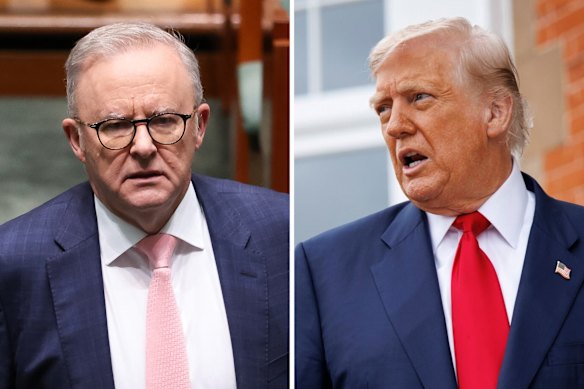- Updated
- Politics
- Federal
- Trade wars
Government scrambling for details after Trump threatens higher tariffs
By Natassia Chrysanthos, Matthew Knott and David Crowe
Australian officials are scrambling to identify whether exports to the United States will be hit with tariffs of up to 20 per cent after Donald Trump’s move to increase import taxes sparked renewed focus on Prime Minister Anthony Albanese’s inability to secure a meeting with the president.
Trump’s indication he would impose tariffs between 15 and 20 per cent within days increases the political pressure on Albanese, who is yet to secure a face-to-face meeting with Trump or an exemption to the current 10 per cent tariffs on Australian goods entering the US.

Prime Minister Anthony Albanese and US President Donald Trump.Credit: Alex Ellinghausen, Bloomberg
Opposition leader Sussan Ley accused Albanese of being a “bystander” to the situation on Tuesday, as senior members of the government either downplayed the risk of a tariff increase or insisted Australia was continuing to engage closely with US counterparts.
“The government seems to be shrugging its shoulders as if there is nothing they can do to address the tariff situation,” Ley said.
“It is not good enough that all these months after Donald Trump became president … the vital meeting between Anthony Albanese and the president has not taken place.”
Trump floated his desire for a single tariff rate for the “rest of the world” at a press conference in Scotland on Monday (UK time), having recently announced trade deals with major economies, including Japan and the European Union.
While Trump did not name Australia as one of the countries to incur the higher tariff range, he made it clear he would not negotiate individual deals with all the remaining countries.
Australian exports are subject to a 10 per cent “baseline” tariff under a White House decision earlier this year, separate to higher tariffs on steel and aluminium. The Albanese government is seeking to avoid higher tariffs, but there has been no sign the countries will reach a deal before Trump’s August 1 deadline.
“It’s a matter of wait and see,” a senior Australian official said, speaking on condition of anonymity. Asked whether the government was expecting a 10, 15 or 20 per cent tariff, the official said: “We haven’t had that level of engagement.”
A spokesman for Trade Minister Don Farrell said Australia maintained its position that any tariffs on Australian goods were unjustified, against the countries’ free trade agreement, and an act of economic self-harm for the US.
Coalition trade spokesman Kevin Hogan said the latest developments underscored the significance of Albanese’s failure to secure an in-person meeting with Trump.
“He needs to go over there and … argue Australia’s case, but also to stand up for free trade across the globe, because the importance of it for us as a trading nation,” he said on Sky News.
Albanese sought to discuss the tariffs with Trump when both attended the G7 summit in Canada in June, but the president left the gathering early to focus on the Middle East, scrapping the Australian talks.
Trump also cancelled meetings with other leaders at the G7, but Albanese has been criticised by the federal opposition for not scheduling another meeting with the president or securing a phone call.
Trump aired his estimate for higher tariffs while speaking in Scotland alongside British Prime Minister Sir Keir Starmer on Tuesday.
“We’re going to be setting a tariff for essentially the rest of the world, and that’s what they’re going to pay if they want to do business in the United States,” Trump said. “Because you can’t sit down and make 200 deals. But we’ve made the big ones.”
Asked to name the figure for the tariffs he wanted to set for the world, Trump said: “I just want to be nice. I would say in the range of 15 to 20 per cent. Probably one of those two numbers.”
Assistant treasurer Daniel Mulino downplayed Trump’s comments, saying it was unsurprising that Trump’s position had changed, given the US president had often sought to increase his bargaining power.
“I think it’s a statement that has been made in an off-the-cuff way. I think we’re going to have to see what specifics come down the pipeline,” he told Sky News on Tuesday morning.
“Australia remains in a situation where we’ve got as good a deal as anybody, and we continue to engage with the US government intensely on these matters.”
Trump named several countries as examples of the “big” deals he had recently negotiated, including an agreement with Indonesia that imposes a 19 per cent tariff on most of its exports to the US. He also named the Philippines, which will incur the same tariff rate.
The deals with Japan and the EU both resulted in tariffs of 15 per cent on most of their exports to the US, though both were announced without full details on all the products subject to the agreed rate.
When Trump applied the 10 per cent baseline tariff on Australia in April, sending a shockwave through the federal election campaign, he cited Australian restrictions on US beef as an issue.
The Australian government eased its restrictions on beef from North America last week, citing scientific advice on biosecurity safeguards. Albanese insisted the move was not made to appease Trump.
The Trump administration, however, portrayed the beef decision as a win for the president.
Get a note directly from our foreign correspondents on what’s making headlines around the world. Sign up for our weekly What in the World newsletter.